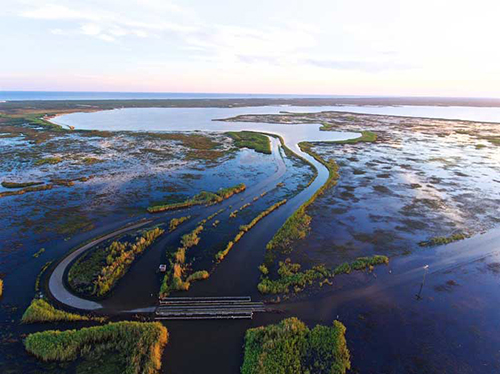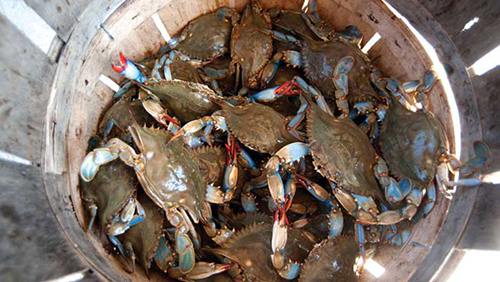No Jimmy Buffet Here
By:
Samantha Brooke
It’s mid-morning on the Texas Gulf Coast, and it’s already hot. The sun sparkles off the water and a slight breeze stirs the air. Even though it is a weekday, people are enjoying themselves — a few refinery workers on their day off are catching fish near a bridge, and small motorboats whizz by. In the distance, the steel towers of oil refineries and liquefied natural gas facilities shimmer in the sun.
This is the Salt Bayou. The largest coastal wetlands complex along the Texas Gulf Coast, it's a favorite destination for birders, fishermen, and hunters. It’s home to one of the nation’s most important waterways where migratory birds winter. The bayou is also the location of some of the most critical oil, gas, military, and manufacturing infrastructure in the world.
Jefferson County Judge Jeff Branick grew up here. It’s where his earliest memories, like the marsh itself, took root.
For Branick and others, the marsh represents more than a good place to fish or a spot to play in the water. The marsh serves as a hurricane buffer, a sort of natural sponge that can absorb just about the worst that nature can throw at the Texas coastline. This is important to the environment as well as to business.
Branick is working with the U.S. Fish and Wildlife Service (Service) as well as other conservation-minded organizations and business interests in the Salt Bayou Watershed Restoration Plan. The program is designed to preserve the marsh’s health — the area’s livelihood, too. For the judge and others, it’s the least they can do. Home is where the heart — and investments — live.
You cannot separate the marsh from the man. Branick was just a child when his grandfather bought a 14-foot aluminum boat and 1958 10-hp Evinrude motor. It set him back $15. The two used it to ply the marsh waters, bringing home flounder, speckled trout and crabs. They did this against the backdrop of a thriving shipping industry.
The passage of years has not lessened commerce on the bayou. Today, Jefferson County, Texas, where Sabine Pass is located, is home to the busiest military port in the United States. Sixty percent of the nation’s strategic petroleum reserve offloads here. Nearby Motiva boasts the largest oil refinery in the nation. Valero, Exxon-Mobil and the French refiner Total have facilities here.
The region is the No.1 exporter of liquid natural gas. Branick also noted that more than 30 chemical plants operate in the area, producing the stuff found in countless consumer products — plastic garbage bags, disposable baby diapers, dish detergents, “you name it.”
Listening to him, you might imagine an industrialized landscape. But what is unique about Jefferson County is that all this industry co-exists with a productive and natural environment that operates to the benefit of everyone.
And don’t forget how the marsh handles storms. It is estimated that for each 2.7 miles of marsh present, one foot of storm surge can be reduced.
Branick still recalls Hurricane Ike, which howled across his homeland 10 years ago. “The only thing that stood between the destruction of our refining capacity and Hurricane Ike was that marsh,” Branick said. “It saved the county.”
The importance of marshes in storm control became clear in the 1930s, when earth-moving equipment created the Gulf Intracoastal Waterway — and built a problem. This waterway, part of the larger Intracoastal system, provides a protected route for commercial barge traffic. But its construction, combined with natural events, altered the landscape sufficiently to cause the bayou’s water to see-saw between fresh and saltwater. The fluctuation was too much for some vegetation, which withered and died — creating expanses of water and reducing the amount of habitat for birds, fish, and crabs.
The loss of the marsh vegetation also reduces the Salt Bayou’s ability to buffer the valuable oil and gas infrastructure and protect area homes from storm surge. That’s why the watershed restoration plan is crucial, its proponents say. It’s focused on reducing the saline concentration in the vulnerable marsh.
A better balance of salt and freshwater, combined with restoration efforts, will improve the health of the marsh vegetation, conditions for the fish, birds, and other animals that live there, and maintain the productive nature of this marsh complex. The people and agencies promoting this plan are diverse. It includes Woody Woodrow, a biologist working in the Service’s Coastal Program. A Texas native, he has for years been active in working to restore the marsh.
In 2013 Woodrow, along with an array of partners, collectively called the Salt Bayou Working Group, completed work on a restoration plan. It represents more than 15 years of data gathering, habitat monitoring and meetings.
Working group partners include the Texas Parks and Wildlife Department (TPWD). Michael Rezsutek, project leader in the TPWD’s Upper Coast Wetlands Ecosystem Project, realized that the task he and others faced would call on a broad range of participants. “One of the hardest things to overcome was developing a plan where everyone saw gains to their interests,” he said.
Ducks Unlimited (DU), another partner, noted that the bayou is home to myriad creatures — American alligators, muskrats, river otters and more — and is a fishery and nursery as well. It’s also a crucial winter habitat for all types of migratory birds.
Private landowners are involved, too. James Broussard collects alligator eggs to supply alligator farmers elsewhere; he’s also a cattleman. Broussard knows that an unhealthy marsh could have an impact on his bottom line.

“We inherited this place,” he said, “and we feel it is our duty to protect it.”
The plan is working. It began with restoring the Keith Lake fish pass to its historic width and depth. That reduced the amount of saltwater coming into the bayou from a large shipping channel. The next step: installing siphons to restore freshwater flows, allowing native vegetation to flourish again.
Restoring the historic beach and dunes at McFaddin National Wildlife Refuge is occurring, too. This $60 million effort, paid for in part with BP Gulf restoration funds stemming from the Deepwater Horizon oil spill, is critical. The beach and dunes form a barrier between gulf storms, the marsh, and the businesses and homes here.
Each small step forward, say project proponents, is cause for celebration. Jim Sutherlin, a DU conservation specialist, understands; the marsh restoration, he said in a recent visit with Woodrow, has been a long time coming.
“We’ve had these ideas in our head since — what, Woody, birth?” he asked. “But this is a good plan; there are some good projects in there.”
For Branick, one thing is clear — whoever comes after him will have to pick up where he left off, taking care of the place where a boy and his grandfather once shared adventures.
“There is a perception among those inland that everyone who lives on the coast is wearing cutoff shorts and flip-flops walking around drinking Landshark beer and listening to Jimmy Buffett, but that’s just not the case,” he said. “These are hardworking people.”
People who see the benefit of restoring the Salt Bayou for their homes, for their businesses, and for their future.